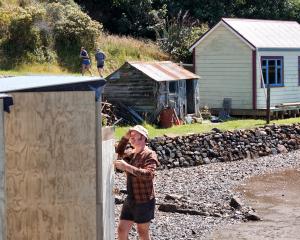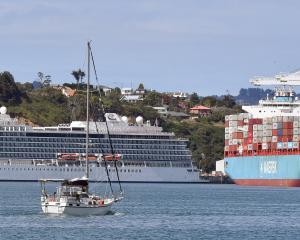
A site of thrills and spills for skateboarders since it opened five years ago, the Dunedin Skateboard Park may be facing its biggest jump yet.
Opened by former Dunedin mayor Sukhi Turner on April 5, 2003, the future of the Thomas Burns St park and its collection of bowls, rails, stairs, pyramids, ledges, boxes and horseshoes is uncertain.
The site has been earmarked for development by the Dunedin City Council, under a proposal to realign roads closer to the railway lines - a proposal that doesn't please skateboard spokesman William van der Vliet.
"I got my hands on this harbourside proposal and I noticed that the skateboard park wasn't there anymore. They had already decided to get rid of it, and they haven't even mentioned a new place for us to go.''
Mr van der Vliet said he and other skateboarders plan to fight the decision unless an alternative home is found for them.
Driven out of the inner city through bylaws, skateboarders had proven they deserved a place in the city, he said.
Beginning skateboarding at the Mornington bowl in the late 1980s, Mr van der Vliet said it was not until the St Clair ramp was built in October 1989 that the sport caught the imagination of Dunedin youth.
The Bones Tour, featuring skateboarder Tony Hawk, visited the city in 1990 showing people what could be achieved with their new facilities, he said.
During the 1990s, skateboarding copied the trend from the United States, moving away from the ramps and on to the streets, much to the annoyance of some Dunedin residents.
Hanging out in the Octagon and the Exchange, the skateboarders became public enemy No 1, and the DCC considered the concept of an inner city skatepark, Mr van der Vliet said.
But before such a facility could be built, a bylaw was passed in 2000, effectively banning skateboarders from the inner city.
"It never worked though... The kids wouldn't give the correct details. It was all a bit stupid,'' he said.
Under the bylaw, warnings were given to people caught skateboarding in the area covered by the ban, with a $50 infringement fee possible.
"Since the opening of the new central-city skateboarding facility... there has been a noticeable reduction in complaints received about skateboarders, skating within the prohibited areas such as the Octagon,'' council environmental health/animal control team leader Ros MacGill said.
Wanting their own place to skate, a group of skateboarders established the Dunedin Bike, Board and Blade Trust - to lobby for a purpose-built facility for skateboarders, in-line skaters and BMX riders.
While an $8 million indoor facility was originally suggested, the council's community development committee voted for the outdoor park on Thomas Burns St. Supported by Mrs Turner and Crs Paul Hudson and Teresa Stevenson, the DCC committed $289,000 to the $347,000 project, with park users contributing the balance, Mr van der Vliet said.
Cr Hudson said the park had been a success, justifying the original investment by the city council.
Driving past the park on most days, Cr Hudson said only once had he noticed the facilities not being utilised.
If the proposed Harbourside development does go ahead, many of the concrete structures built for the park were portable, he said.
"We could move it to a new location, possibly near where it is now. These things only have a life of a few years before they become a bit dated with the skaters.''
However, Mr van der Vliet said the skateboarders would only move if they had a place to go.
"We got caught out last time with having no place to skateboard. This time we need a place built if we are going to move.''
"We have developed a real community down there,'' Mr van der Vliet said.
Built to also cater for in-line skaters and BMX riders, the park was used by only one in-line skater, but was still popular with BMX riders and skateboarders, particularly on weekends and after school.
"It has a great atmosphere. Everyone knows each other and it doesn't matter where you come from or what you do, people are here to skate - not to compete,'' he said.
Since the demise of the railway bridge, the skateboarders had lost the appreciative onlookers - largely tourists from the nearby Taieri Gorge Railway and people finishing work. But with the demise of the bridge, skateboarders had noticed a decline in the amount of broken glass in the park.
"We always get the blame for the things that happen around the area, because we are the ones people see,'' he said.
Helping Mr van der Vliet clean up broken glass from the area, Evan Roberts said the skateboard park was a great place to take his son, Finn (14).
"I gave up skating 30 years ago and have just taken it back up again. It is a great thing to do together, even though he is better than me.''
Requiring concentration, hand eye co-ordination and a good level of fitness, skateboarding was a great sport for young, and old alike to try, he said.
"These are a good bunch of kids. I just hope if the council decides to bowl this down they have the foresight to make something better for them.''
Before the skateboard park was opened, Leroy Cunningham (20) used to skateboard at the Mornington bowl, but preferred skateboarding in town "because it was a bit of a hike up there''.
While skateboarding at the Golden Centre car park, Mr Cunningham was issued with a trespass notice, so he was relieved when the park finally opened.
"It was real cool,'' he said. "I just love it here.''
A pupil at John McGlashan College, 18-year old Richard Stevenson is one of the stars of the skateboard park's bowl.
"I have been coming here every day for about two and a-half years. It has really helped my skating and everyone is supportive.
Attracting families, males and females, the young and old, the skateboard park had evolved from just a place to "hide the kids'' to its own fully-fledged community, Mr van der Vliet said.
Addicted to the thrill of the wheels hitting the concrete is 10-year old Mitch Stirling, who skates to the graffiti-covered park from his home in Ravensbourne.
"I really like it here. I have been coming about eight months.''
Enjoying skateboarding on the horseshoe, Mitch said he wants to land a trick over the difficult "steps'', a 1m drop on to concrete.












